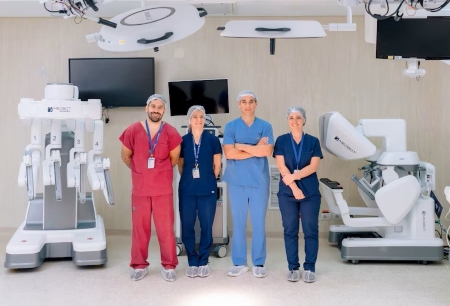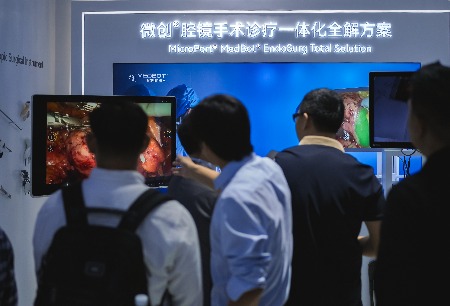Sichuan, China —— A case of robot-assisted transbronchial lung biopsy (TBLB) was successfully completed in West China Hospital under the joint collaboration of Professor Weimin Li, Professor Dan Liu and their team of West China Hospital on March 30, 2022 with the robot-assisted bronchoscopy navigation system (MicroPort® bronchoscopic robot) jointly and independently developed by Shanghai MicroPort MedBot (Group) Co., Ltd., West China Hospital of Sichuan University (West China Hospital) and Shanghai Chest Hospital. This is the first-in-man (FIM) clinical trial with the Chinese-developed bronchoscopic surgery robot as well as the first surgical breakthrough achieved by Chinese-developed surgery robot in the field of non-invasion through natural cavity.
This patient, a 62-year-old female, went to West China Hospital because of "cough for 2+ months". Her chest CT indicated soft tissue shadow at the upper tip of left lung, but no abnormality was discovered in the lumen under ordinary bronchoscope. The nature of her lung lesions is unknown. After detailed evaluation by Professor Dan Liu's team and full communication with the patient and her family members, it was determined to adopt MicroPort® bronchoscopic robot to assist in the transbronchial lung biopsy(TBLB).
Before operation, Professor Weimin Li and Professor Dan Liu and their team input the CT images of the patient's lungs into the planning software of MicroPort® bronchoscopic robot, and the system generated a 3D high-precision model of anatomical structure of the patient's lungs. During the operation, Professor Weimin Li and Professor Dan Liu accurately controlled the bronchoscope to enter the posterior bronchus of upper lobe of left lung and reach the target position through the specially-designed operating handle under the guidance of the software, and successfully completed the biopsy under the dual location of endoscopic direct vision and virtual image, and concluded success of the biopsy simultaneously with the rapid on-site evaluationI(ROSE). The patient had no obvious discomfort after operation and was satisfied with the diagnosis and treatment process.
MicroPort® bronchoscopic robot is a non-invasive robot operating platform through natural cavity. It has a super-supple, super-slender snake-shaped robot catheter, and can enter the narrow lesion space that is hard to reach through the natural cavity of human body without surface trauma. It is of great significance for early diagnosis and treatment of early-stage cancer lesions such as pulmonary nodules. Its precise image navigation system provides the real-time in-vivo surgical guidance for surgical operations, evades the important blood vessels and organs, and assists the doctors in completing surgical operations safely, efficiently and accurately; its slender snake-shape robot catheter ensures its access to deeper lesion area of the lung, which is expected to truly achieve full lung coverage; the system can achieve the whole chain integration of intelligent surgical assistance, such as preoperative planning, respiratory compensation, and intraoperative surgical guidance of robots, and realize an integrated intelligent diagnosis and treatment solution for lung diseases.
Lung cancer is the most common malignant tumor and the leading cause of cancer death in China. It is one of the most serious malignant tumors threatening the people's health and life. Of all lung cancer patients in different stages, the 5-year survival rate is only 18%, so lung cancer is called as a "Silent Killer". According to statistics, it is estimated that by 2025, the number of people dying of lung cancer in China will amount to 1 million a year, with an annual growth rate of 26.9%. Early diagnosis and treatment of lung cancer with tiny pulmonary nodules is the key measure to reduce the mortality rate of lung cancer. In terms of tiny pulmonary nodules, traditional bronchoscopy faces great challenges, and it is difficult for endoscopy to reach the deep areas of lesion, so the probability of obtaining pathological diagnosis is low. Moreover, the traditional percutaneous biopsy is not suitable for tiny pulmonary nodules with the false negative risk existing. It is of great significance for the early diagnosis and treatment of small nodules in lung cancer to solve the limitations of the existing biopsy methods and allow doctors to control the direction of some pulmonary branches in real time to reach the deep areas of lung airway and achieve the access to entire lungs. There are only two international products that have been authorized to be marketized overseas, but there are no Chinese-developed products. Bronchoscopic surgery robot is an important gap for the development of Chinese-developed surgery robot.
As early as 2020, when the COVID-19 epidemic broke out all over the world, MicroPort®MedBot® quickly started the research and development project of bronchoscopic robot, and joined the team of Professor Weimin Li from West China Hospital and Professor Jiayuan Sun from Shanghai Chest Hospital to lay out the pulmonary interventional robot. In April of the same year, the first-in-man (FIM) clinical trial was completed with the world's first bronchial surgery robot for COVID-19. With the advantages of R&D and innovation in the field of surgical robots and the accumulation of key core technologies, the joint development team focused on the clinical hard-to-tackle points and needs of lung diseases. After two years of continuous exploration and technical research, the joint development team finally made breakthroughs in the core technology of bronchoscopic surgery robots and entered the stage of clinical trials, thus filling up the gap of domestic technology and industry. Through the close integration mechanism of medicine and engineering, MicroPort®MedBot®, West China Hospital and Shanghai Chest Hospital have jointly created important milestone breakthroughs in the field of accurate diagnosis and treatment of lung diseases and non-invasion through natural cavity.
-
 2025-12-24Toumai® Becomes the First Chinese Surgical Robot to Achieve the Milestone of 100 Commercial Installations
2025-12-24Toumai® Becomes the First Chinese Surgical Robot to Achieve the Milestone of 100 Commercial Installations -
 2025-12-05Toumai®-Assisted Robotic Ovarian Tissue Autotransplantation Successfully Performed for the First Time in Argentina
2025-12-05Toumai®-Assisted Robotic Ovarian Tissue Autotransplantation Successfully Performed for the First Time in Argentina -
 2025-11-14Toumai® Robotic Fluorescence Imaging System Receives EU CE Certification
2025-11-14Toumai® Robotic Fluorescence Imaging System Receives EU CE Certification






 Hu ICP Bei No. 20013662 HGWA Bei No. 31011502015178
Hu ICP Bei No. 20013662 HGWA Bei No. 31011502015178 " are registered trademarks of Shanghai MicroPort Medical (Group) Co., Ltd.” . They have been authorized to be used by Shanghai Microport Medbot (Group) Co., Ltd., and no other party shall use such trademarks without prior written permission thereof.
" are registered trademarks of Shanghai MicroPort Medical (Group) Co., Ltd.” . They have been authorized to be used by Shanghai Microport Medbot (Group) Co., Ltd., and no other party shall use such trademarks without prior written permission thereof.
